IOM Electronics Ltd: Functional Areas in Business Report Analysis
VerifiedAdded on 2023/01/04
|8
|1953
|95
Report
AI Summary
This report analyzes the functional areas of a business, using IOM Electronics Ltd. as a case study. It defines business and functional areas, emphasizing their importance in organizational structure. The report details key functional areas like marketing, human resources, customer service, finance, research and development, and sales, outlining their roles and responsibilities. Furthermore, it describes the skills required for employees in each functional area, such as interpersonal skills for marketing, empathetic skills for HR, persuasive power for customer service, analytical skills for finance, innovational skills for R&D, and listening skills for sales. The report concludes by highlighting how functional areas streamline business operations and maintain organizational efficiency. References from various business and management publications are included to support the analysis.
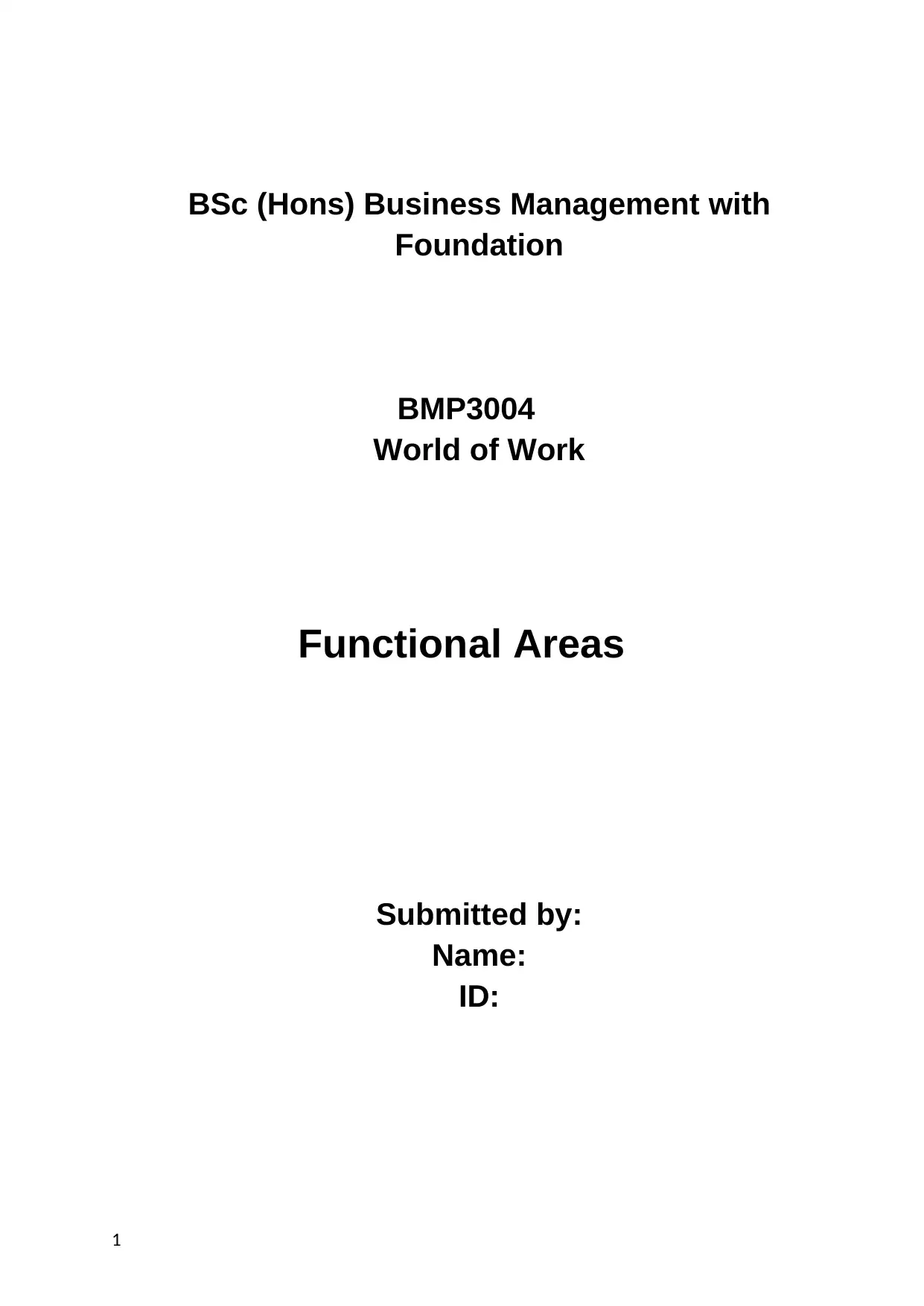
BSc (Hons) Business Management with
Foundation
BMP3004
World of Work
Functional Areas
Submitted by:
Name:
ID:
1
Foundation
BMP3004
World of Work
Functional Areas
Submitted by:
Name:
ID:
1
Paraphrase This Document
Need a fresh take? Get an instant paraphrase of this document with our AI Paraphraser

2
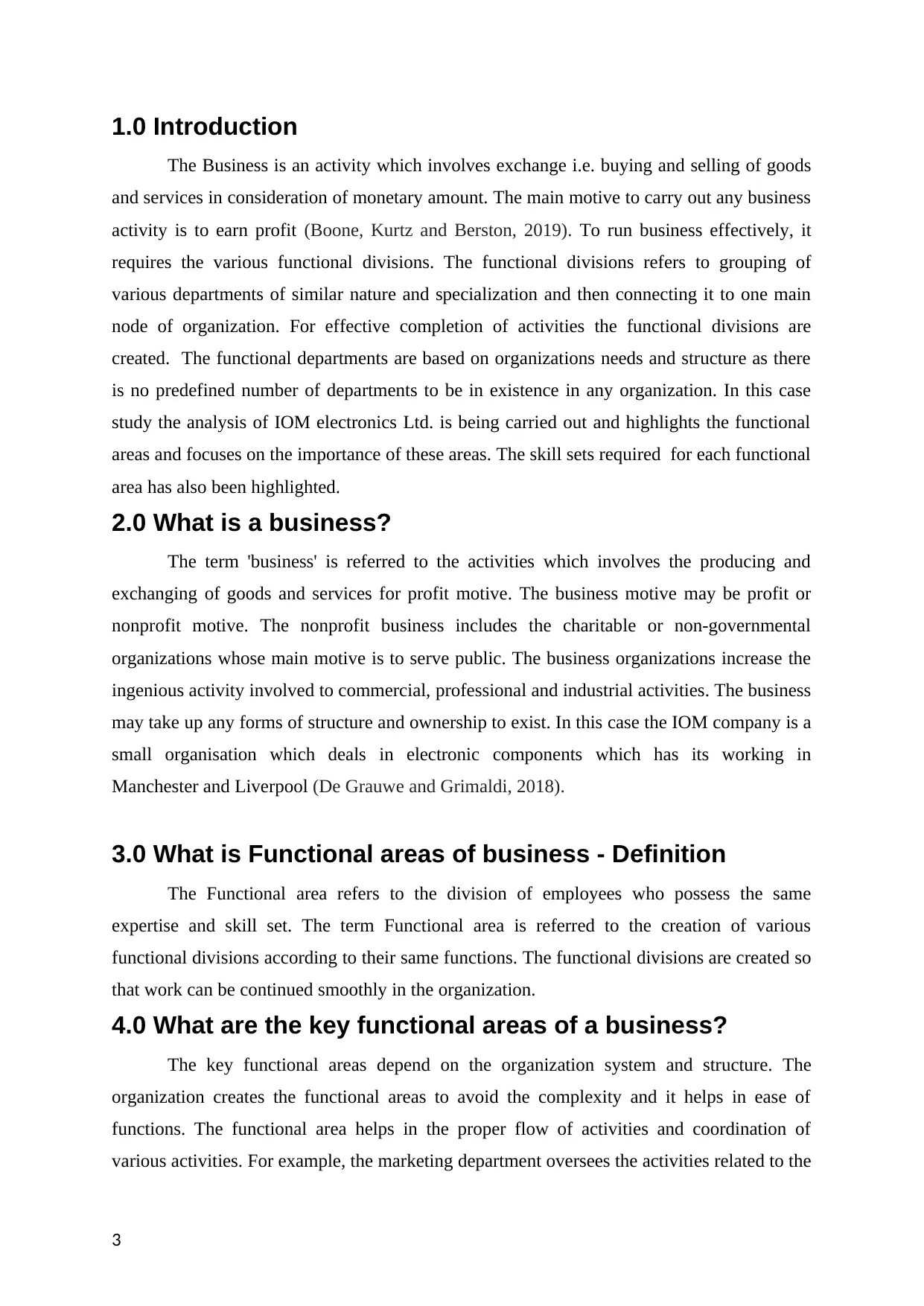
1.0 Introduction
The Business is an activity which involves exchange i.e. buying and selling of goods
and services in consideration of monetary amount. The main motive to carry out any business
activity is to earn profit (Boone, Kurtz and Berston, 2019). To run business effectively, it
requires the various functional divisions. The functional divisions refers to grouping of
various departments of similar nature and specialization and then connecting it to one main
node of organization. For effective completion of activities the functional divisions are
created. The functional departments are based on organizations needs and structure as there
is no predefined number of departments to be in existence in any organization. In this case
study the analysis of IOM electronics Ltd. is being carried out and highlights the functional
areas and focuses on the importance of these areas. The skill sets required for each functional
area has also been highlighted.
2.0 What is a business?
The term 'business' is referred to the activities which involves the producing and
exchanging of goods and services for profit motive. The business motive may be profit or
nonprofit motive. The nonprofit business includes the charitable or non-governmental
organizations whose main motive is to serve public. The business organizations increase the
ingenious activity involved to commercial, professional and industrial activities. The business
may take up any forms of structure and ownership to exist. In this case the IOM company is a
small organisation which deals in electronic components which has its working in
Manchester and Liverpool (De Grauwe and Grimaldi, 2018).
3.0 What is Functional areas of business - Definition
The Functional area refers to the division of employees who possess the same
expertise and skill set. The term Functional area is referred to the creation of various
functional divisions according to their same functions. The functional divisions are created so
that work can be continued smoothly in the organization.
4.0 What are the key functional areas of a business?
The key functional areas depend on the organization system and structure. The
organization creates the functional areas to avoid the complexity and it helps in ease of
functions. The functional area helps in the proper flow of activities and coordination of
various activities. For example, the marketing department oversees the activities related to the
3
The Business is an activity which involves exchange i.e. buying and selling of goods
and services in consideration of monetary amount. The main motive to carry out any business
activity is to earn profit (Boone, Kurtz and Berston, 2019). To run business effectively, it
requires the various functional divisions. The functional divisions refers to grouping of
various departments of similar nature and specialization and then connecting it to one main
node of organization. For effective completion of activities the functional divisions are
created. The functional departments are based on organizations needs and structure as there
is no predefined number of departments to be in existence in any organization. In this case
study the analysis of IOM electronics Ltd. is being carried out and highlights the functional
areas and focuses on the importance of these areas. The skill sets required for each functional
area has also been highlighted.
2.0 What is a business?
The term 'business' is referred to the activities which involves the producing and
exchanging of goods and services for profit motive. The business motive may be profit or
nonprofit motive. The nonprofit business includes the charitable or non-governmental
organizations whose main motive is to serve public. The business organizations increase the
ingenious activity involved to commercial, professional and industrial activities. The business
may take up any forms of structure and ownership to exist. In this case the IOM company is a
small organisation which deals in electronic components which has its working in
Manchester and Liverpool (De Grauwe and Grimaldi, 2018).
3.0 What is Functional areas of business - Definition
The Functional area refers to the division of employees who possess the same
expertise and skill set. The term Functional area is referred to the creation of various
functional divisions according to their same functions. The functional divisions are created so
that work can be continued smoothly in the organization.
4.0 What are the key functional areas of a business?
The key functional areas depend on the organization system and structure. The
organization creates the functional areas to avoid the complexity and it helps in ease of
functions. The functional area helps in the proper flow of activities and coordination of
various activities. For example, the marketing department oversees the activities related to the
3
⊘ This is a preview!⊘
Do you want full access?
Subscribe today to unlock all pages.

Trusted by 1+ million students worldwide
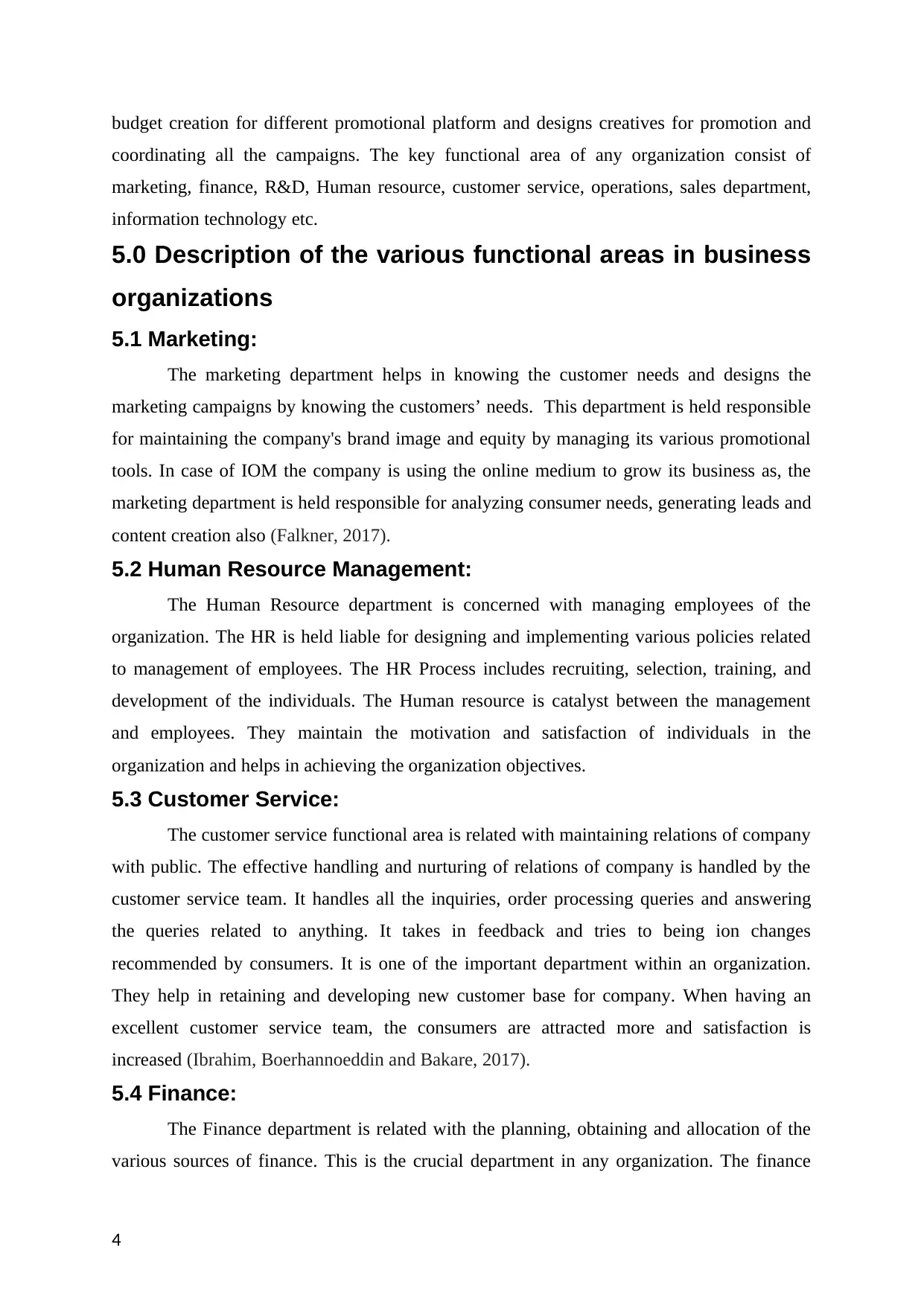
budget creation for different promotional platform and designs creatives for promotion and
coordinating all the campaigns. The key functional area of any organization consist of
marketing, finance, R&D, Human resource, customer service, operations, sales department,
information technology etc.
5.0 Description of the various functional areas in business
organizations
5.1 Marketing:
The marketing department helps in knowing the customer needs and designs the
marketing campaigns by knowing the customers’ needs. This department is held responsible
for maintaining the company's brand image and equity by managing its various promotional
tools. In case of IOM the company is using the online medium to grow its business as, the
marketing department is held responsible for analyzing consumer needs, generating leads and
content creation also (Falkner, 2017).
5.2 Human Resource Management:
The Human Resource department is concerned with managing employees of the
organization. The HR is held liable for designing and implementing various policies related
to management of employees. The HR Process includes recruiting, selection, training, and
development of the individuals. The Human resource is catalyst between the management
and employees. They maintain the motivation and satisfaction of individuals in the
organization and helps in achieving the organization objectives.
5.3 Customer Service:
The customer service functional area is related with maintaining relations of company
with public. The effective handling and nurturing of relations of company is handled by the
customer service team. It handles all the inquiries, order processing queries and answering
the queries related to anything. It takes in feedback and tries to being ion changes
recommended by consumers. It is one of the important department within an organization.
They help in retaining and developing new customer base for company. When having an
excellent customer service team, the consumers are attracted more and satisfaction is
increased (Ibrahim, Boerhannoeddin and Bakare, 2017).
5.4 Finance:
The Finance department is related with the planning, obtaining and allocation of the
various sources of finance. This is the crucial department in any organization. The finance
4
coordinating all the campaigns. The key functional area of any organization consist of
marketing, finance, R&D, Human resource, customer service, operations, sales department,
information technology etc.
5.0 Description of the various functional areas in business
organizations
5.1 Marketing:
The marketing department helps in knowing the customer needs and designs the
marketing campaigns by knowing the customers’ needs. This department is held responsible
for maintaining the company's brand image and equity by managing its various promotional
tools. In case of IOM the company is using the online medium to grow its business as, the
marketing department is held responsible for analyzing consumer needs, generating leads and
content creation also (Falkner, 2017).
5.2 Human Resource Management:
The Human Resource department is concerned with managing employees of the
organization. The HR is held liable for designing and implementing various policies related
to management of employees. The HR Process includes recruiting, selection, training, and
development of the individuals. The Human resource is catalyst between the management
and employees. They maintain the motivation and satisfaction of individuals in the
organization and helps in achieving the organization objectives.
5.3 Customer Service:
The customer service functional area is related with maintaining relations of company
with public. The effective handling and nurturing of relations of company is handled by the
customer service team. It handles all the inquiries, order processing queries and answering
the queries related to anything. It takes in feedback and tries to being ion changes
recommended by consumers. It is one of the important department within an organization.
They help in retaining and developing new customer base for company. When having an
excellent customer service team, the consumers are attracted more and satisfaction is
increased (Ibrahim, Boerhannoeddin and Bakare, 2017).
5.4 Finance:
The Finance department is related with the planning, obtaining and allocation of the
various sources of finance. This is the crucial department in any organization. The finance
4
Paraphrase This Document
Need a fresh take? Get an instant paraphrase of this document with our AI Paraphraser
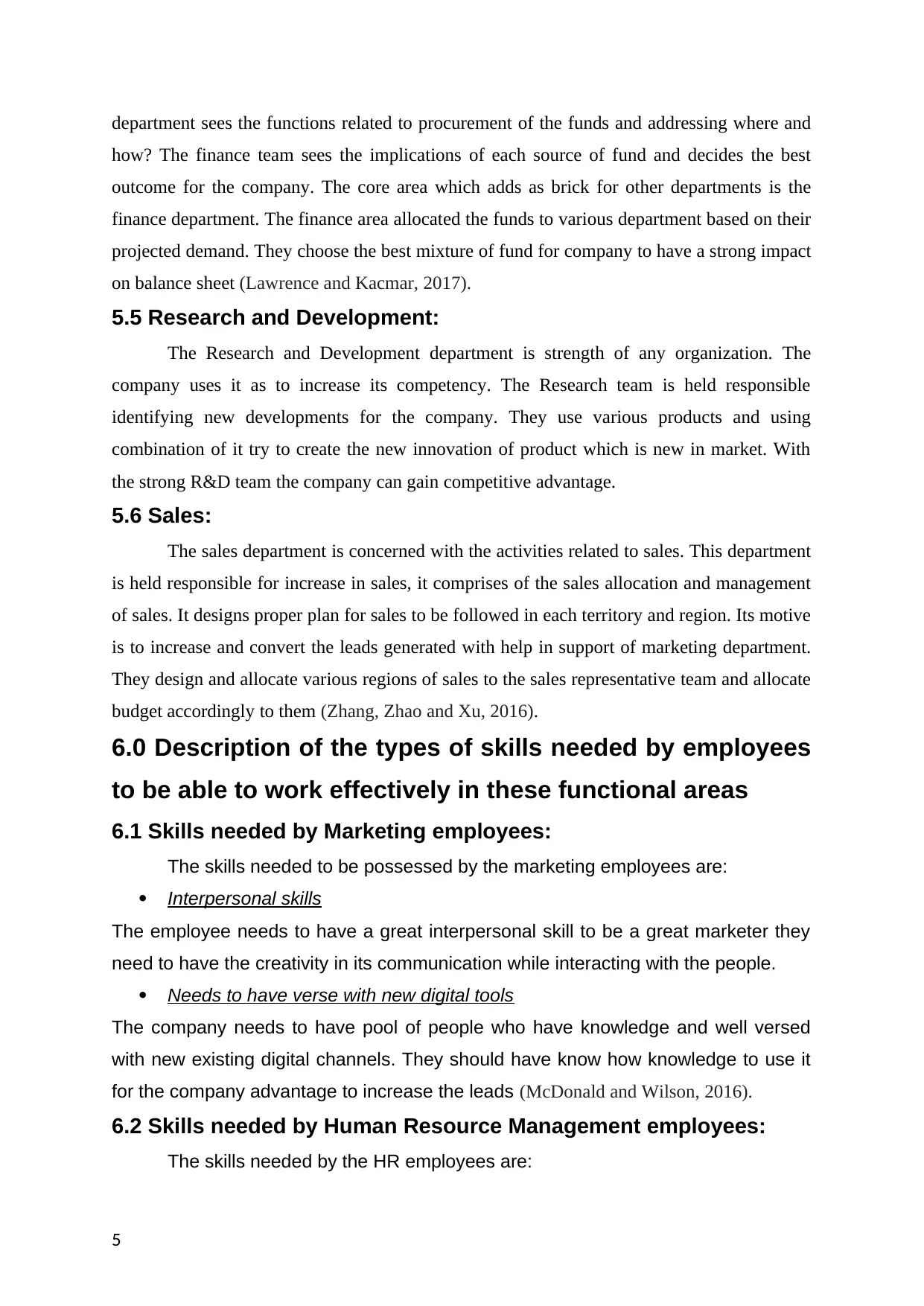
department sees the functions related to procurement of the funds and addressing where and
how? The finance team sees the implications of each source of fund and decides the best
outcome for the company. The core area which adds as brick for other departments is the
finance department. The finance area allocated the funds to various department based on their
projected demand. They choose the best mixture of fund for company to have a strong impact
on balance sheet (Lawrence and Kacmar, 2017).
5.5 Research and Development:
The Research and Development department is strength of any organization. The
company uses it as to increase its competency. The Research team is held responsible
identifying new developments for the company. They use various products and using
combination of it try to create the new innovation of product which is new in market. With
the strong R&D team the company can gain competitive advantage.
5.6 Sales:
The sales department is concerned with the activities related to sales. This department
is held responsible for increase in sales, it comprises of the sales allocation and management
of sales. It designs proper plan for sales to be followed in each territory and region. Its motive
is to increase and convert the leads generated with help in support of marketing department.
They design and allocate various regions of sales to the sales representative team and allocate
budget accordingly to them (Zhang, Zhao and Xu, 2016).
6.0 Description of the types of skills needed by employees
to be able to work effectively in these functional areas
6.1 Skills needed by Marketing employees:
The skills needed to be possessed by the marketing employees are:
Interpersonal skills
The employee needs to have a great interpersonal skill to be a great marketer they
need to have the creativity in its communication while interacting with the people.
Needs to have verse with new digital tools
The company needs to have pool of people who have knowledge and well versed
with new existing digital channels. They should have know how knowledge to use it
for the company advantage to increase the leads (McDonald and Wilson, 2016).
6.2 Skills needed by Human Resource Management employees:
The skills needed by the HR employees are:
5
how? The finance team sees the implications of each source of fund and decides the best
outcome for the company. The core area which adds as brick for other departments is the
finance department. The finance area allocated the funds to various department based on their
projected demand. They choose the best mixture of fund for company to have a strong impact
on balance sheet (Lawrence and Kacmar, 2017).
5.5 Research and Development:
The Research and Development department is strength of any organization. The
company uses it as to increase its competency. The Research team is held responsible
identifying new developments for the company. They use various products and using
combination of it try to create the new innovation of product which is new in market. With
the strong R&D team the company can gain competitive advantage.
5.6 Sales:
The sales department is concerned with the activities related to sales. This department
is held responsible for increase in sales, it comprises of the sales allocation and management
of sales. It designs proper plan for sales to be followed in each territory and region. Its motive
is to increase and convert the leads generated with help in support of marketing department.
They design and allocate various regions of sales to the sales representative team and allocate
budget accordingly to them (Zhang, Zhao and Xu, 2016).
6.0 Description of the types of skills needed by employees
to be able to work effectively in these functional areas
6.1 Skills needed by Marketing employees:
The skills needed to be possessed by the marketing employees are:
Interpersonal skills
The employee needs to have a great interpersonal skill to be a great marketer they
need to have the creativity in its communication while interacting with the people.
Needs to have verse with new digital tools
The company needs to have pool of people who have knowledge and well versed
with new existing digital channels. They should have know how knowledge to use it
for the company advantage to increase the leads (McDonald and Wilson, 2016).
6.2 Skills needed by Human Resource Management employees:
The skills needed by the HR employees are:
5
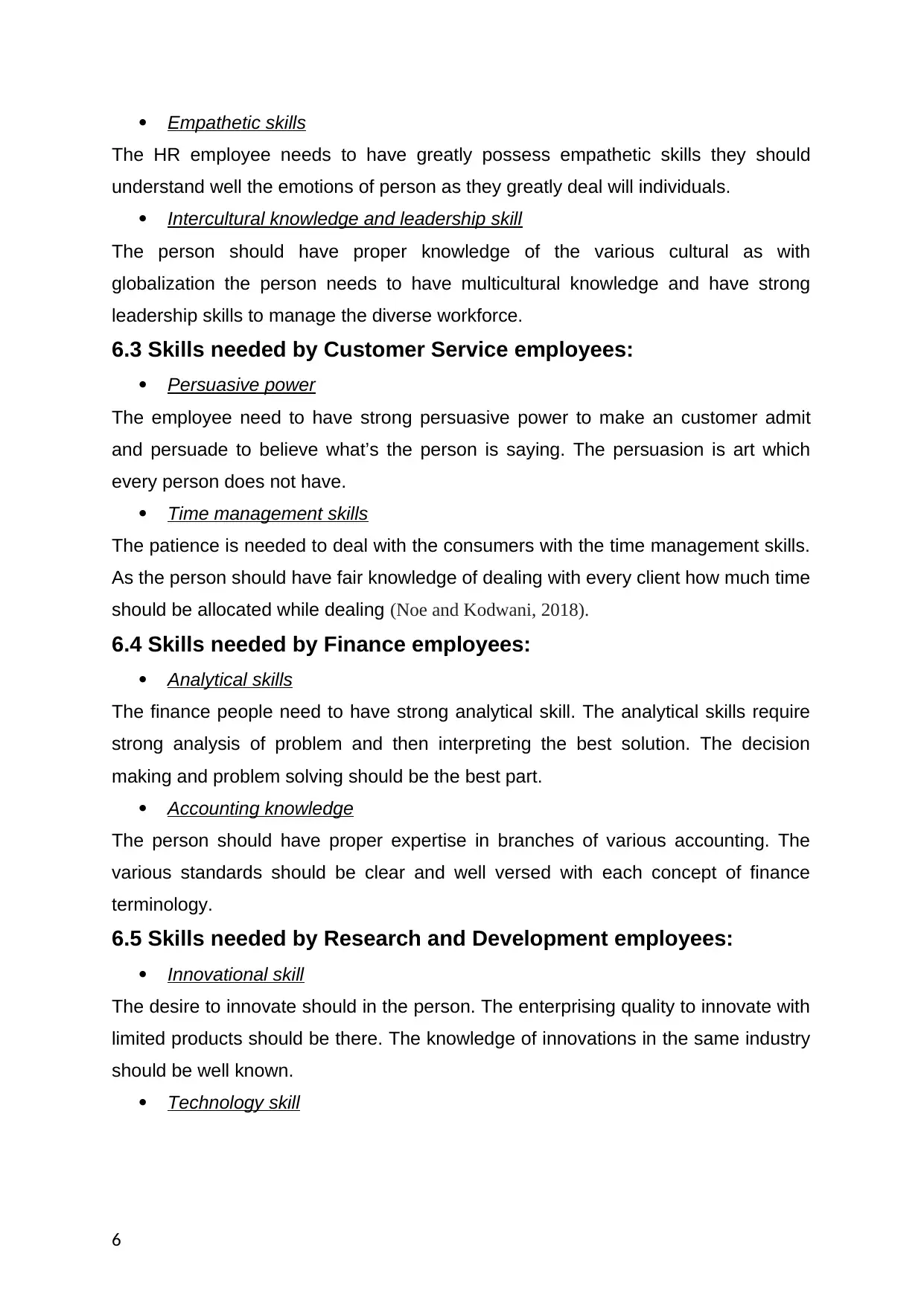
Empathetic skills
The HR employee needs to have greatly possess empathetic skills they should
understand well the emotions of person as they greatly deal will individuals.
Intercultural knowledge and leadership skill
The person should have proper knowledge of the various cultural as with
globalization the person needs to have multicultural knowledge and have strong
leadership skills to manage the diverse workforce.
6.3 Skills needed by Customer Service employees:
Persuasive power
The employee need to have strong persuasive power to make an customer admit
and persuade to believe what’s the person is saying. The persuasion is art which
every person does not have.
Time management skills
The patience is needed to deal with the consumers with the time management skills.
As the person should have fair knowledge of dealing with every client how much time
should be allocated while dealing (Noe and Kodwani, 2018).
6.4 Skills needed by Finance employees:
Analytical skills
The finance people need to have strong analytical skill. The analytical skills require
strong analysis of problem and then interpreting the best solution. The decision
making and problem solving should be the best part.
Accounting knowledge
The person should have proper expertise in branches of various accounting. The
various standards should be clear and well versed with each concept of finance
terminology.
6.5 Skills needed by Research and Development employees:
Innovational skill
The desire to innovate should in the person. The enterprising quality to innovate with
limited products should be there. The knowledge of innovations in the same industry
should be well known.
Technology skill
6
The HR employee needs to have greatly possess empathetic skills they should
understand well the emotions of person as they greatly deal will individuals.
Intercultural knowledge and leadership skill
The person should have proper knowledge of the various cultural as with
globalization the person needs to have multicultural knowledge and have strong
leadership skills to manage the diverse workforce.
6.3 Skills needed by Customer Service employees:
Persuasive power
The employee need to have strong persuasive power to make an customer admit
and persuade to believe what’s the person is saying. The persuasion is art which
every person does not have.
Time management skills
The patience is needed to deal with the consumers with the time management skills.
As the person should have fair knowledge of dealing with every client how much time
should be allocated while dealing (Noe and Kodwani, 2018).
6.4 Skills needed by Finance employees:
Analytical skills
The finance people need to have strong analytical skill. The analytical skills require
strong analysis of problem and then interpreting the best solution. The decision
making and problem solving should be the best part.
Accounting knowledge
The person should have proper expertise in branches of various accounting. The
various standards should be clear and well versed with each concept of finance
terminology.
6.5 Skills needed by Research and Development employees:
Innovational skill
The desire to innovate should in the person. The enterprising quality to innovate with
limited products should be there. The knowledge of innovations in the same industry
should be well known.
Technology skill
6
⊘ This is a preview!⊘
Do you want full access?
Subscribe today to unlock all pages.

Trusted by 1+ million students worldwide
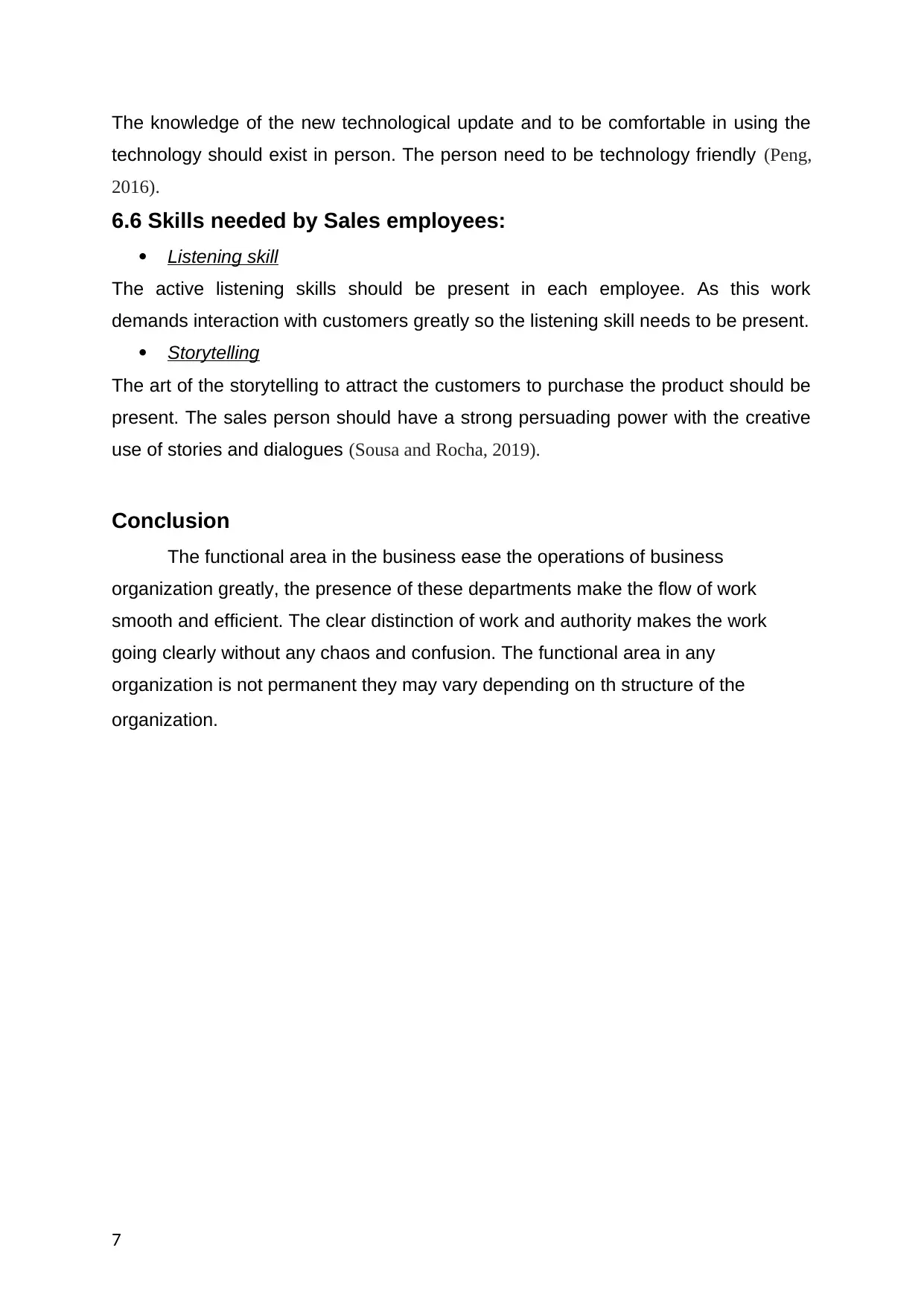
The knowledge of the new technological update and to be comfortable in using the
technology should exist in person. The person need to be technology friendly (Peng,
2016).
6.6 Skills needed by Sales employees:
Listening skill
The active listening skills should be present in each employee. As this work
demands interaction with customers greatly so the listening skill needs to be present.
Storytelling
The art of the storytelling to attract the customers to purchase the product should be
present. The sales person should have a strong persuading power with the creative
use of stories and dialogues (Sousa and Rocha, 2019).
Conclusion
The functional area in the business ease the operations of business
organization greatly, the presence of these departments make the flow of work
smooth and efficient. The clear distinction of work and authority makes the work
going clearly without any chaos and confusion. The functional area in any
organization is not permanent they may vary depending on th structure of the
organization.
7
technology should exist in person. The person need to be technology friendly (Peng,
2016).
6.6 Skills needed by Sales employees:
Listening skill
The active listening skills should be present in each employee. As this work
demands interaction with customers greatly so the listening skill needs to be present.
Storytelling
The art of the storytelling to attract the customers to purchase the product should be
present. The sales person should have a strong persuading power with the creative
use of stories and dialogues (Sousa and Rocha, 2019).
Conclusion
The functional area in the business ease the operations of business
organization greatly, the presence of these departments make the flow of work
smooth and efficient. The clear distinction of work and authority makes the work
going clearly without any chaos and confusion. The functional area in any
organization is not permanent they may vary depending on th structure of the
organization.
7
Paraphrase This Document
Need a fresh take? Get an instant paraphrase of this document with our AI Paraphraser
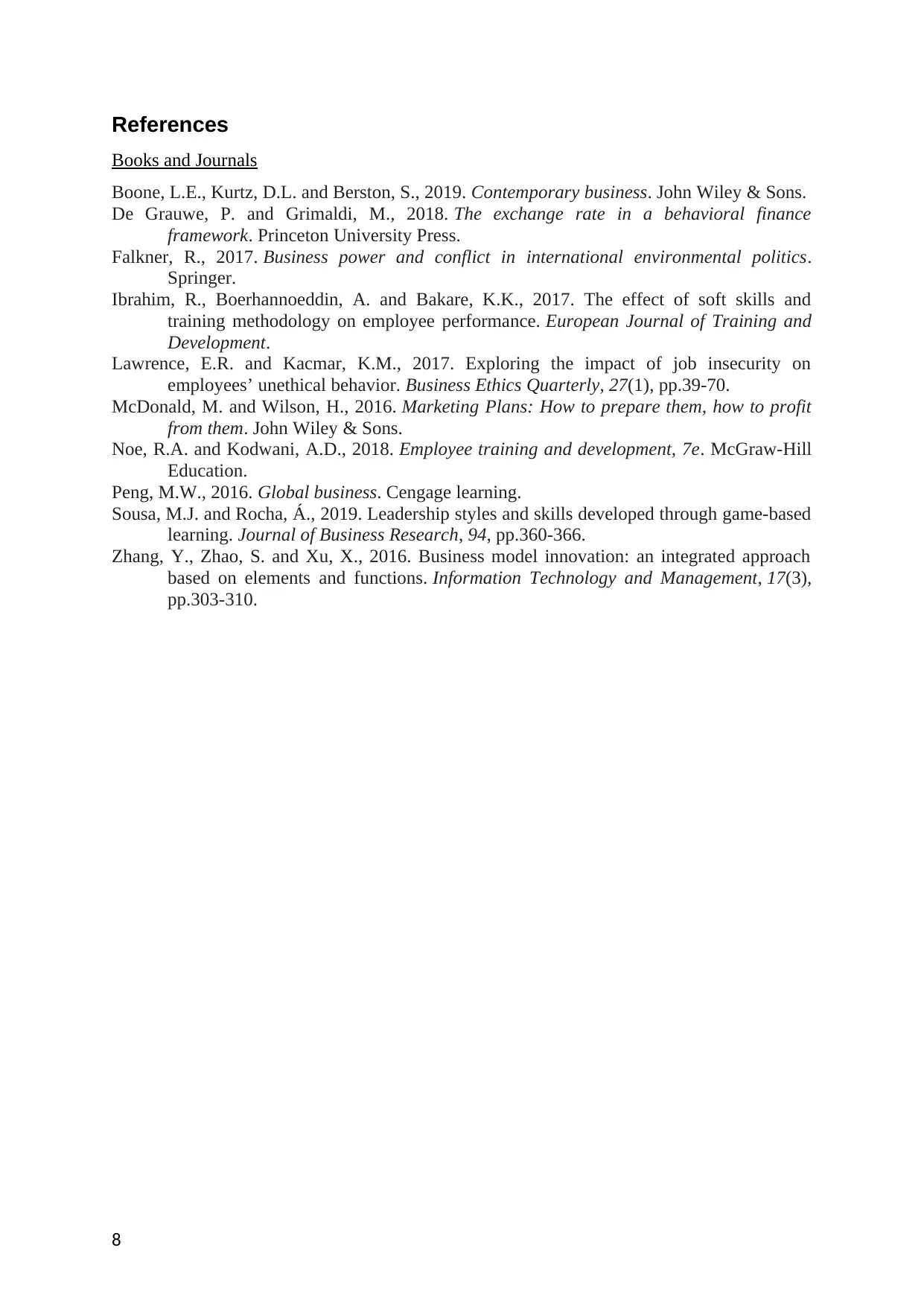
References
Books and Journals
Boone, L.E., Kurtz, D.L. and Berston, S., 2019. Contemporary business. John Wiley & Sons.
De Grauwe, P. and Grimaldi, M., 2018. The exchange rate in a behavioral finance
framework. Princeton University Press.
Falkner, R., 2017. Business power and conflict in international environmental politics.
Springer.
Ibrahim, R., Boerhannoeddin, A. and Bakare, K.K., 2017. The effect of soft skills and
training methodology on employee performance. European Journal of Training and
Development.
Lawrence, E.R. and Kacmar, K.M., 2017. Exploring the impact of job insecurity on
employees’ unethical behavior. Business Ethics Quarterly, 27(1), pp.39-70.
McDonald, M. and Wilson, H., 2016. Marketing Plans: How to prepare them, how to profit
from them. John Wiley & Sons.
Noe, R.A. and Kodwani, A.D., 2018. Employee training and development, 7e. McGraw-Hill
Education.
Peng, M.W., 2016. Global business. Cengage learning.
Sousa, M.J. and Rocha, Á., 2019. Leadership styles and skills developed through game-based
learning. Journal of Business Research, 94, pp.360-366.
Zhang, Y., Zhao, S. and Xu, X., 2016. Business model innovation: an integrated approach
based on elements and functions. Information Technology and Management, 17(3),
pp.303-310.
8
Books and Journals
Boone, L.E., Kurtz, D.L. and Berston, S., 2019. Contemporary business. John Wiley & Sons.
De Grauwe, P. and Grimaldi, M., 2018. The exchange rate in a behavioral finance
framework. Princeton University Press.
Falkner, R., 2017. Business power and conflict in international environmental politics.
Springer.
Ibrahim, R., Boerhannoeddin, A. and Bakare, K.K., 2017. The effect of soft skills and
training methodology on employee performance. European Journal of Training and
Development.
Lawrence, E.R. and Kacmar, K.M., 2017. Exploring the impact of job insecurity on
employees’ unethical behavior. Business Ethics Quarterly, 27(1), pp.39-70.
McDonald, M. and Wilson, H., 2016. Marketing Plans: How to prepare them, how to profit
from them. John Wiley & Sons.
Noe, R.A. and Kodwani, A.D., 2018. Employee training and development, 7e. McGraw-Hill
Education.
Peng, M.W., 2016. Global business. Cengage learning.
Sousa, M.J. and Rocha, Á., 2019. Leadership styles and skills developed through game-based
learning. Journal of Business Research, 94, pp.360-366.
Zhang, Y., Zhao, S. and Xu, X., 2016. Business model innovation: an integrated approach
based on elements and functions. Information Technology and Management, 17(3),
pp.303-310.
8
1 out of 8
Related Documents
Your All-in-One AI-Powered Toolkit for Academic Success.
+13062052269
info@desklib.com
Available 24*7 on WhatsApp / Email
![[object Object]](/_next/static/media/star-bottom.7253800d.svg)
Unlock your academic potential
Copyright © 2020–2025 A2Z Services. All Rights Reserved. Developed and managed by ZUCOL.




